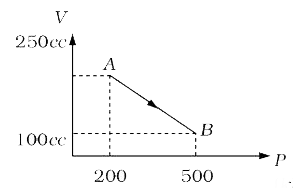A system changes from state X to Y with a change in internal energy measuring to 25 kJ mol−1, by a reversible path and returns from Y to X by an irreversible path. What will be the net change in internal energy?
The correct Answer is:0
To solve the problem step by step, we need to understand the concept of internal energy and how it behaves during reversible and irreversible processes.
Step 1: Identify the initial and final states
The system changes from state X to state Y, and then returns from state Y to state X.
Hint: Always identify the states involved in the process.
Step 2: Understand the change in internal energy
The change in internal energy (ΔU) from state X to state Y is given as +25 kJ/mol. This means that the internal energy of the system increases by 25 kJ/mol when moving from X to Y.
Hint: Remember that a positive ΔU indicates an increase in internal energy.
Step 3: Analyze the return path
The system returns from state Y to state X via an irreversible path. However, it is important to note that the internal energy of a system is a state function, which means it depends only on the initial and final states, not on the path taken.
Hint: Internal energy is a state function; it does not depend on how the change occurs.
Step 4: Calculate the net change in internal energy
Since the system returns to its original state (state X), the net change in internal energy for the entire process (from X to Y and back to X) can be calculated as follows:
- Change from X to Y: +25 kJ/mol
- Change from Y back to X: -25 kJ/mol (since it returns to the original state)
Thus, the total change in internal energy is:
ΔU_total = ΔU(X to Y) + ΔU(Y to X) = +25 kJ/mol - 25 kJ/mol = 0 kJ/mol.
Hint: When calculating total changes in state functions, sum the changes and consider the sign.
Conclusion
The net change in internal energy for the entire process is 0 kJ/mol.
Final Answer
The net change in internal energy is 0 kJ/mol.
The system changes from state X to state Y, and then returns from state Y to state X.
The change in internal energy (ΔU) from state X to state Y is given as +25 kJ/mol. This means that the internal energy of the system increases by 25 kJ/mol when moving from X to Y.
The system returns from state Y to state X via an irreversible path. However, it is important to note that the internal energy of a system is a state function, which means it depends only on the initial and final states, not on the path taken.
Since the system returns to its original state (state X), the net change in internal energy for the entire process (from X to Y and back to X) can be calculated as follows:
- Change from X to Y: +25 kJ/mol
- Change from Y back to X: -25 kJ/mol (since it returns to the original state)
ΔU_total = ΔU(X to Y) + ΔU(Y to X) = +25 kJ/mol - 25 kJ/mol = 0 kJ/mol.
The net change in internal energy for the entire process is 0 kJ/mol.
The net change in internal energy is 0 kJ/mol.
Similar Questions
In a reversible isothermal process, the change in internal energy is :
View SolutionThe internal energy change when a system goes fromk state A to B is 40kJmol−1. If the system goes from A to B by a reversible path and returns to state A by an irreversible path, what would be the net change in internal energy?
View Solution
Knowledge Check
A system absorbs 50 kJ heat and does 20 kJ of work. What is the net change in the internal energy of the system ?
AIncrease by 30 kJBDecrease by 30 kJCIncrease by 70 kJDDecrease by 70 kJ
What happens to the change in internal energy of a gas during adiabatic expansion?
View SolutionHow will you find the change in internal energy of a system when it melts ?
View Solution160 J of work is done on the system and at the same time 100 J of heat is given out. What is the change in the internal energy ?
View Solution180 J of work is done on the system and at the same time 120 J of heat is given out. What is the change in the internal energy?
View SolutionCalculate change in internal energy if ΔH=−92.2kJ,P=40 atm and ΔV=−11.
View SolutionWhat is the change in internal energy of a system undergoing a cyclic process, at the end of a cycle ?
View SolutionA mono-atomic gas is taken along path AB as shown. Calculate change in internal energy of the gas.

View Solution
